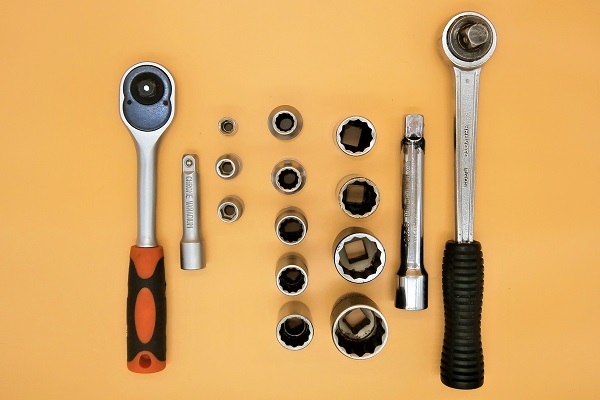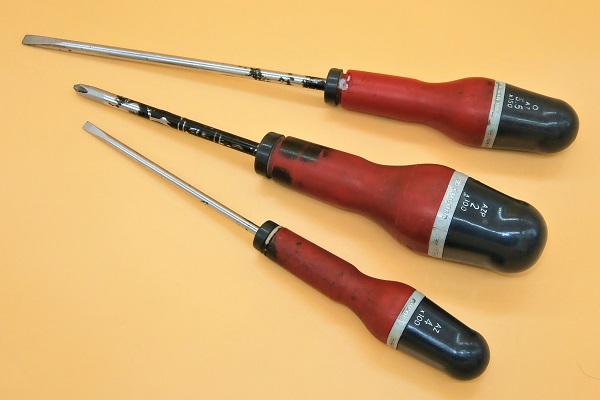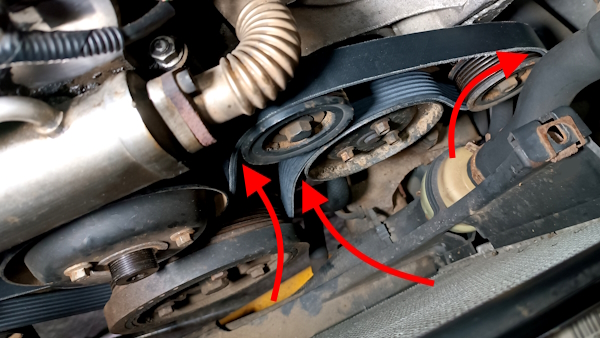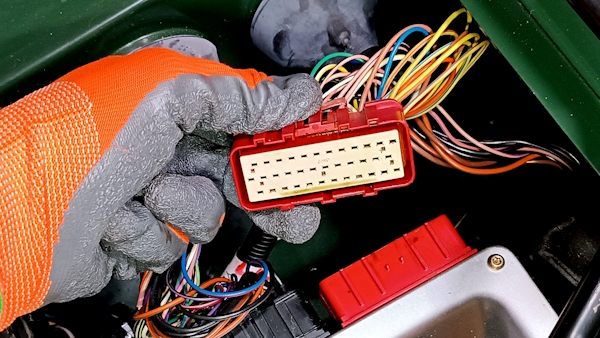Renew the coolant on Defender Td5
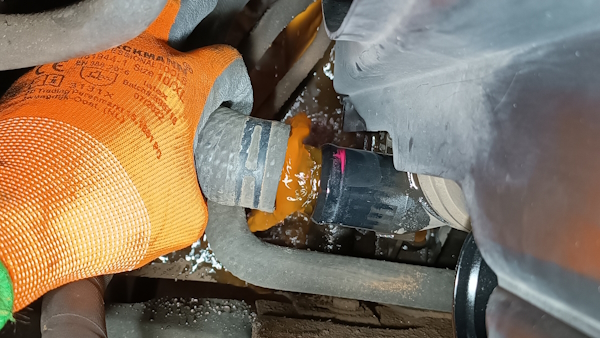
Vehicle ➔ Defender 110 Td5 2002
Difficulty ➔ Medium

Time ➔ 2 hours
Summary

This tutorial concerns only the Defender Td5.

What is the role of coolant ?
• Regulate the engine operating temperature and prevent overheating.
• Resists freezing in winter. This is why it is commonly called antifreeze.
• Protects engine parts against corrosion thanks to its anticorrosive properties.
• Do not deposit any residue (e.g. scale) in the cooling system.
• Regulate the engine operating temperature and prevent overheating.
• Resists freezing in winter. This is why it is commonly called antifreeze.
• Protects engine parts against corrosion thanks to its anticorrosive properties.
• Do not deposit any residue (e.g. scale) in the cooling system.

Why change the coolant regularly ?
• Over time, the coolant becomes loaded with impurities. It takes on a brown color. It can then clog the cooling system and the heater system.
• Over time, the anticorrosive properties of the coolant decrease and the cooling system is less well protected against rust.
• Over time, the coolant becomes acidic and can then damage the seals.
• Over time, the coolant becomes loaded with impurities. It takes on a brown color. It can then clog the cooling system and the heater system.
• Over time, the anticorrosive properties of the coolant decrease and the cooling system is less well protected against rust.
• Over time, the coolant becomes acidic and can then damage the seals.

The engine must be cold when draining the cooling system. Never open the expansion tank cap when the engine is hot. When the engine is hot the coolant is under pressure. You could generate projections and serious burns.

Coolant is polluting. Its release into nature is prohibited. When draining, collect the used coolant in a container and take it to the recycling center.
The coolant recommended by Land Rover

Total capacity of the Defender Td5 cooling system (with heater system) : 13 liters.

Land Rover recommends coolant : Texaco XLC Long Life.
• It is an OTC coolant (Organic Technology Coolant Concentrate).
• This coolant meets Ford WSS-M97B44-D requirements.
• It is an OTC coolant (Organic Technology Coolant Concentrate).
• This coolant meets Ford WSS-M97B44-D requirements.

In Land Rover stores, coolant is available under the references :
• STC50529 : 1 liter can.
• STC50530 : 5 liter can.
• STC50529 : 1 liter can.
• STC50530 : 5 liter can.

This ''Long Life'' coolant offers 5 years of protection. This allows the cooling system drain intervals to be extended.

Texaco XLC Long Life coolant is concentrated. It must be mixed with demineralized water.
• The minimum dilution should not be less than 50% coolant + 50% demineralized water. This proportion ensures engine protection down to -36°C.
• The maximum dilution should not be greater than 60% coolant + 40% demineralized water.
• The minimum dilution should not be less than 50% coolant + 50% demineralized water. This proportion ensures engine protection down to -36°C.
• The maximum dilution should not be greater than 60% coolant + 40% demineralized water.

Texaco XLC Long Life coolant should not be mixed with a conventional coolant during top-up.

On our Defender Td5, we use coolant : Ravenol OTC Coolant & Antifreeze.
• This coolant meets Ford WSS-M97B44-D requirements.
• It has the same characteristics as the reference STC50529 and it is much cheaper.
• This coolant meets Ford WSS-M97B44-D requirements.
• It has the same characteristics as the reference STC50529 and it is much cheaper.
Coolant drain plug

Some Defender Td5 have a bottom radiator hose (1st photo) fitted with a drain plug (2nd photo). Although our Defender is equipped with one, we prefer to drain the coolant by disconnecting the bottom radiator hose. This allows us to remove as much coolant as possible.
Complete draining of the cooling system is impossible ?

Whatever the method used, there will always be coolant left (around 5 liters) in the cooling system. To minimize this volume, our tutorial includes some additional operations compared to the Land Rover procedure :
• Manually compress the top hose and the water pump hose (Op 15 and 16).
• Blow lightly into the rigid heater pipe and into the expansion tank with an air gun (Op 19 and 21).
These additional operations are not essential, but they allow to drain a few extra deciliters of coolant.
• Manually compress the top hose and the water pump hose (Op 15 and 16).
• Blow lightly into the rigid heater pipe and into the expansion tank with an air gun (Op 19 and 21).
These additional operations are not essential, but they allow to drain a few extra deciliters of coolant.
How to obtain the correct dilution of coolant and demineralized water ?

As we have already said, when draining the cooling system, we only manage to remove 8 liters of coolant out of the 13 liters that the cooling system contains. So there are 5 liters left in the cooling system.

The method we apply is as follows :
• Drain the cooling system by disconnecting the bottom radiator hose.
• Fill and bleed the cooling system with only demineralized water.
• Drive a few kilometers with the heater control in the maximum position.
• Drain the cooling system again.
• Fill and bleed the cooling system with 6.5 liters of concentrated coolant then demineralized water.
• Drain the cooling system by disconnecting the bottom radiator hose.
• Fill and bleed the cooling system with only demineralized water.
• Drive a few kilometers with the heater control in the maximum position.
• Drain the cooling system again.
• Fill and bleed the cooling system with 6.5 liters of concentrated coolant then demineralized water.

The advantages of this method are :
• During the 1st draining, the 5 liters of used coolant remaining in the cooling system are diluted with the demineralized water that we put in the cooling system.
• During the 2nd draining, we can consider that there is almost only demineralized water left in the cooling system.
• We do not introduce tap water into the cooling system, which avoids any limescale deposits.
• During the 1st draining, the 5 liters of used coolant remaining in the cooling system are diluted with the demineralized water that we put in the cooling system.
• During the 2nd draining, we can consider that there is almost only demineralized water left in the cooling system.
• We do not introduce tap water into the cooling system, which avoids any limescale deposits.

This method makes it possible to finally obtain a 50% dilution of coolant + 50% demineralized water :
• 5 liters of demineralized water (remaining in the Defender cooling system).
• 6.5 liters of concentrated coolant (added).
• 1.5 liter of demineralized water (added).
• 5 liters of demineralized water (remaining in the Defender cooling system).
• 6.5 liters of concentrated coolant (added).
• 1.5 liter of demineralized water (added).
Advertisement
Drain the cooling system
Op 01
Place the heater control in the maximum open position.
Op 02
Remove the acoustic cover (➔ see the tutorial ''Engine oil change on Defender Td5'' Op 05 to 07).
Op 03
Remove the cooling fan cowl (➔ see the tutorial ''Viscous fan change on Defender Td5'' Op 02 and 03).
Op 04
Place a drain pan under the radiator.

Place a large drain pan because when you disconnect the bottom radiator hose, it will splash.
Op 05
Remove the expansion tank cap. Unscrew by hand.

Never remove the expansion tank cap when the engine is hot. When the engine is hot the coolant is under pressure. You could generate projections and serious burns.
Op 06
Locate the intercooler / inlet manifold hose.

On our Defender, we have removed the EGR valve. This is why the hose is connected directly to the inlet manifold which has been extended by a small metal tube (in place of the EGR valve).
Op 07
Loosen and move the hose fixing clip on the inlet manifold. Use a 6 mm socket spanner.
Op 08
Loosen and move the hose fixing clip on the intercooler. Use a 6 mm socket and several extensions.

The clip is located at the bottom of the radiator and is only accessible from the top of the radiator. Several extensions are therefore necessary to access it.
Op 09
Disconnect the hose from the intercooler. Pull by hand.
Op 10
Disconnect the hose from the inlet manifold. Pull by hand.
Remove the hose.
Op 11
Locate the bottom radiator hose.
Op 12
Move the bottom hose fixing clip on the radiator. Use the multigrip pliers.

The bottom hose clip is a spring clip. Simply squeeze it with pliers to loosen it.
Op 13
Disconnect the bottom hose from the radiator. Pull by hand.
Let the coolant drain.
Op 14
Lower the side of the bottom hose that you just disconnected. Pull by hand.
Let the coolant drain.

Lowering the hose allows a maximum amount of coolant to be drained.
Op 15
Compress the top radiator hose. Squeeze it by hand.

Compress the top hose several times as long as coolant flows through the bottom hose.
Op 16
Also compress the water pump hose. Squeeze it by hand.
Op 17
Move the heater hose fixing clip. Use the multigrip pliers.

It is not essential to blow into the heater system (Op 17 to 20) to drain the cooling system. You can skip it. Nevertheless, this allows to drain a few extra deciliters of coolant.
Op 18
Disconnect the heater hose from the rigid pipe. Pull by hand.
Op 19
Blow lightly into the rigid heater pipe. Use a compressor and an air gun.

Do not blow too hard to avoid damaging the cooling system and the heater radiator.

Use a cloth to approximately seal the air gun/pipe junction.

Blow as long as coolant flows through the bottom hose.
Op 20
Fit the heater hose to the rigid pipe. Push by hand.
Fit its fixing clip. Use the multigrip pliers.
Op 21
Blow lightly into the expansion tank. Use the compressor and air gun.

Do not blow too hard to avoid damaging the cooling system and the radiator.

Blow as long as coolant flows through the bottom hose.
Op 22
Fit the bottom hose to the radiator. Push by hand.
Op 23
Fit the bottom radiator hose fixing clip. Use the multigrip pliers.
Op 24
Fit the hose to the inlet manifold and to the intercooler. Push by hand.
Op 25
Position and screw the hose fixing clips on the inlet manifold and on the intercooler. Use the 6 mm spanner and the 6 mm socket with several extensions.
Op 26
Fit the cooling fan cowl (➔ see the tutorial ''Viscous fan change on Defender Td5'' Op 09 and 10).
Fill the cooling system with demineralized water and drive 10 km
Op 27
Locate the top radiator hose and its bleed screw.
Op 28
Unscrew and remove the bleed screw located on the top radiator hose. Use a flathead screwdriver.
Op 29
Fill the cooling system with demineralized water through the expansion tank until water comes out through the bleed hole of the top hose.
Op 30
Fit and screw the bleed screw (PYP10008L) on the top hose. Use the flathead screwdriver.
Op 31
Continue filling the expansion tank with demineralized water up to the ''Cold Level'' mark.

The cold level is marked on the left side of the expansion tank (2nd photo).
Op 32
Fit the expansion tank cap. Screw by hand.
Op 33
Start the engine.
Let the engine run until it reaches its operating temperature.

If the premises where the Defender is parked is not sufficiently ventilated, move it outside the building.
Op 34
Stop the engine and let it cool.
Op 35
Add demineralized water to the expansion tank to reach the ''Cold Level'' mark.
Op 36
Drive approximately 10 km with the heater control in the maximum position.
Drain the cooling system again
Op 37
Drain the cooling system again. Repeat operations from Op 03 to 26.
Fill and bleed the cooling system with concentrated coolant and demineralized water
Op 38
Fill and bleed the cooling system. Repeat operations from Op 27 to 35 but this time :
•
Start by pouring 6.5 liters of concentrated coolant (1st and 2nd photos),
•
Then top up with demineralized water (3rd photo).

This method makes it possible to finally obtain a 50% dilution of coolant + 50% demineralized water :
• 5 liters of demineralized water (remaining in the Defender cooling system).
• 6.5 liters of concentrated coolant (added).
• 1.5 liter of demineralized water (added).
• 5 liters of demineralized water (remaining in the Defender cooling system).
• 6.5 liters of concentrated coolant (added).
• 1.5 liter of demineralized water (added).
Op 39
Fit the acoustic cover (➔ see the tutorial ''Engine oil change on Defender Td5'' Op 44 to 46).
The End








